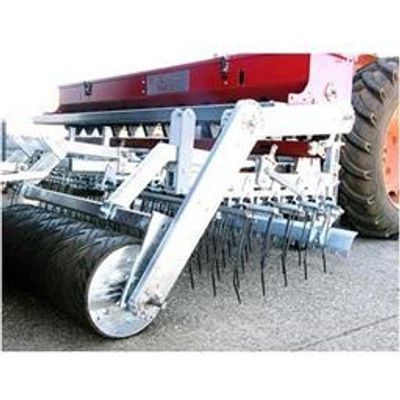

- Home
- Companies
- Fix Enterprises
- Products
- Seed Fix - 4 in 1 Adaptive Seed box

Seed Fix - 4 in 1 Adaptive Seed box
Pastures usually provide the only income for graziers & dairy farmers, etc. Without pastures there is no meat, milk, or wool. Often grazing paddocks contain more weeds than productive pasture species. This is understandable, because it has been difficult to establish good pasture. Often pasture seed is broadcast with a spinner type fertiliser spreader. These types of spreaders cannot spread fertiliser evenly, so how can they sow pasture seed mixes with seeds of different sizes, density and specific gravity evenly?
Then there are sod seeders and disc seeders of various makes and types. These machines have been designed to sow cereal grains in rows. Modifications have been made to supposedly make them suitable to sow pasture. They are not adequate because of the seed is sown in rows and often buried too deep.
The natural way for pasture seed to germinate is on the surface, in contact with the soil, so why bury the seed. If you bury the seed to deep this is exactly what happens. It stays buried and dies. Then of course sowing in lines or rows does not make any sense either. If the seed does germinate, the empty spaces between the rows will allow weeds to grow with obvious loss of production. Apart from the effort and time required to sow pasture, the cost of quality pasture seed is expensive. Sowing with inadequate equipment ads to the expense! Less than optimum placement of the seed reduces production. Why would anyone use inadequate implements for sowing pasture and miss out on yield and income.
The best way to establish pasture is by placing the seed in to contact with the soil evenly spaced over the whole area as opposed to rows! When germination occurs, a blanket cover of new pasture seedlings will ensure fast total establishment of new pasture. This will help to suppress the weeds and ensure full production much earlier. Achieving this has a significant economic benefit. The best machine by far for this task is the Seed Fix 4 in 1 pasture seeder. This machine is designed for sowing pastures in to either worked ground and over-sowing in to existing pastures rejuvenate or total re-sow in many instances without the need to cultivate. Seed Fix 4 in 1 is extremely cost effective and supplied in 2, 3, and
4 m working widths.
No one has a perfect mix of pasture species right through. Every farm can improve their pasture and therefore their productivity. With the Seed Fix 4 in 1, this task has never been more accurate, faster or easier.
Depending on ground conditions, high seeding speeds are possible.
Seed Fix 4 in 1 is the choice for all pasture species and many other small seeds
including Lucerne.
- Seed Fix 4 in 1 is the ideal machine for turf production and sports grounds re- and over sowing.
- Seed Fix 4 in 1 is designed and constructed in Australia for Australian farmers and sports grounds.
- See Seed Fix 4 In 1 over leaf.
- Seed boxes only from 1m to 4 m working width can be supplied to mount on to other implements.
The following procedure is for all seed box widths!
Before commencing to seed, the Seed Fix box must be calibrated!
Four in line outlets (= 1 metre spreading width) are used for calibration on all width boxes!
Only put seed in to these 4 outlets! Place trough or sheet under these outlets to catch seed.
Make sure you know the circumpherence of the metering wheel or drive roller!
Divide the circumference in to 100. This is equivalent to 100 m2 = 100th of 1 HA.
Example: 1.1 m circumference = 91 turns for 100 m 150 grams = 15 KG per HA
For rough calibration, divide circumference in to 100 for the turns = 9 for 10 square m -15 grams = 15 kg per HA
Before you start!!!
- Make sure the seeder-adjusting knob is set further in than you think you need.
- Check all the choke slides are set the same.
- Be sure you collect all the seed when calibrating with sheet or trough.
- Turn the wheel the required revolutions (with the drop bolt in the slot) and weigh the seed.
- Multiply the weight of the seed by 100 to get grams per HA or divide by 10 for KG per HA
- Adjust the metering knob as needed and weigh the seed each time to achieve the required seeding rate per HA. Make sure the drop bolt is in the lock position!!
- For more accurate seeding find out the number of seeds per KG. and germination rate.
- Then calculate the desired population per Ha.
Never force the knob! If the turn gets hard, relieve some seed from the distribution units by turning the metering wheel then start again!
Note the setting by recording the number of threads visible from the control knob
